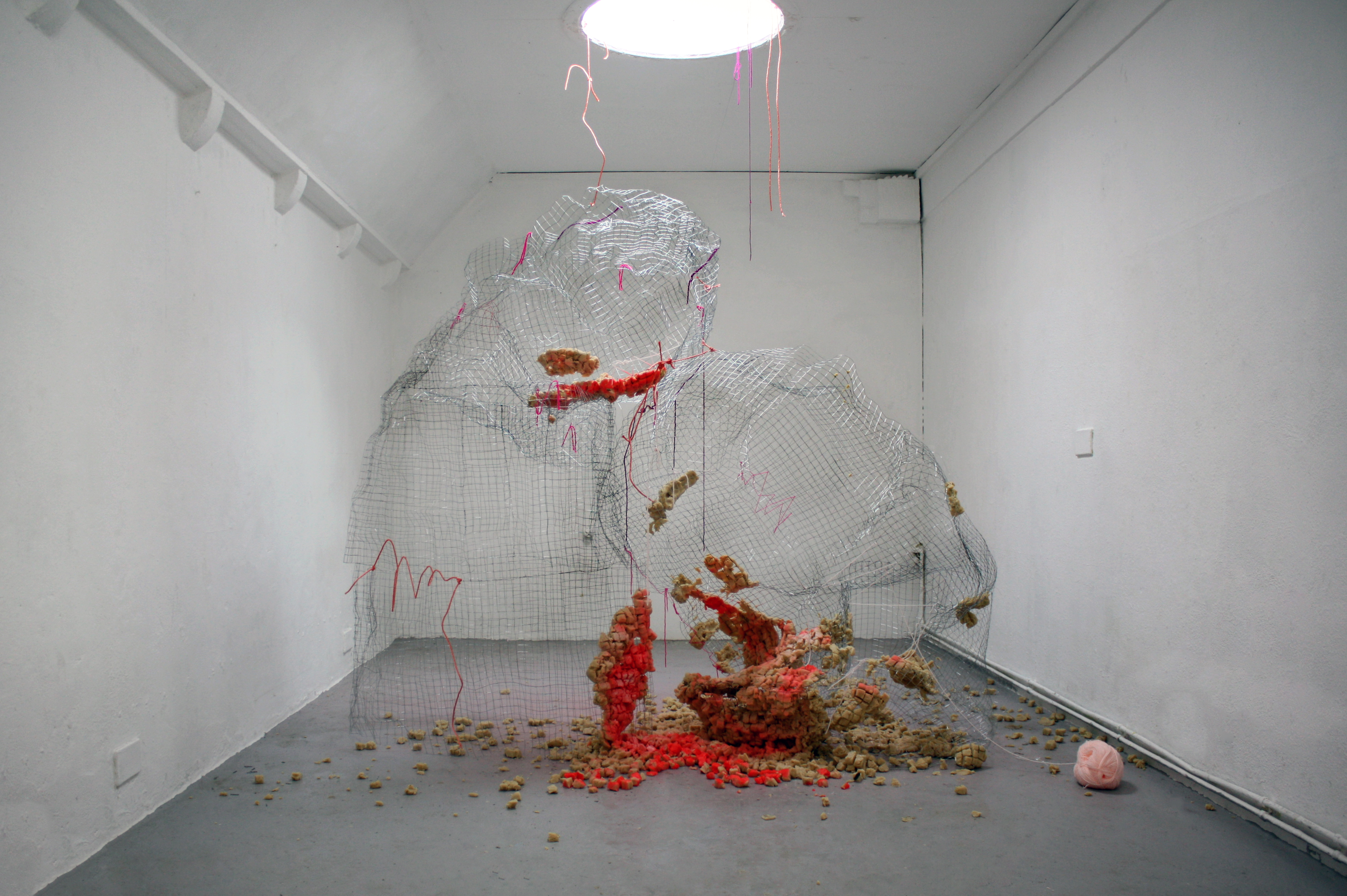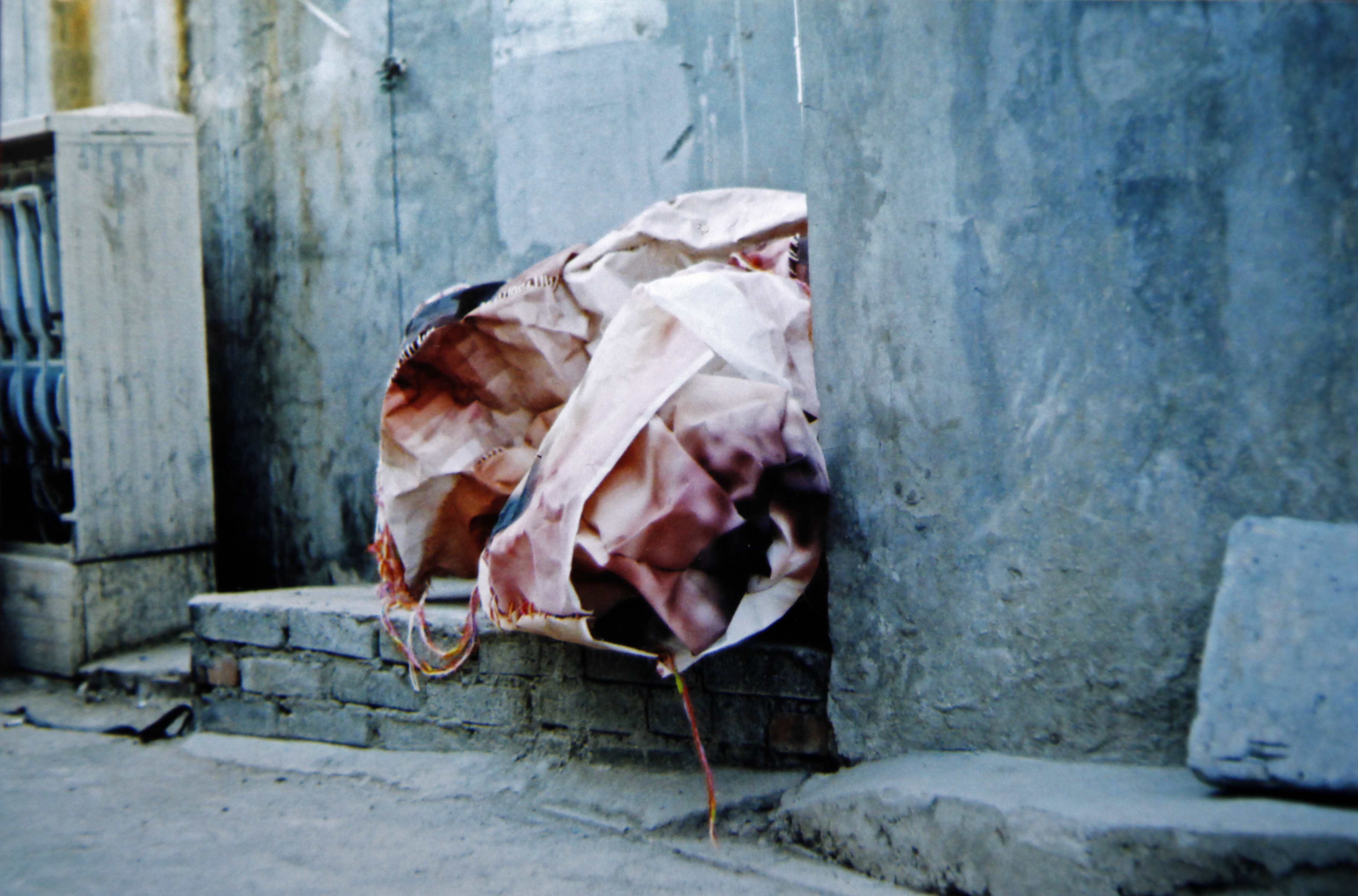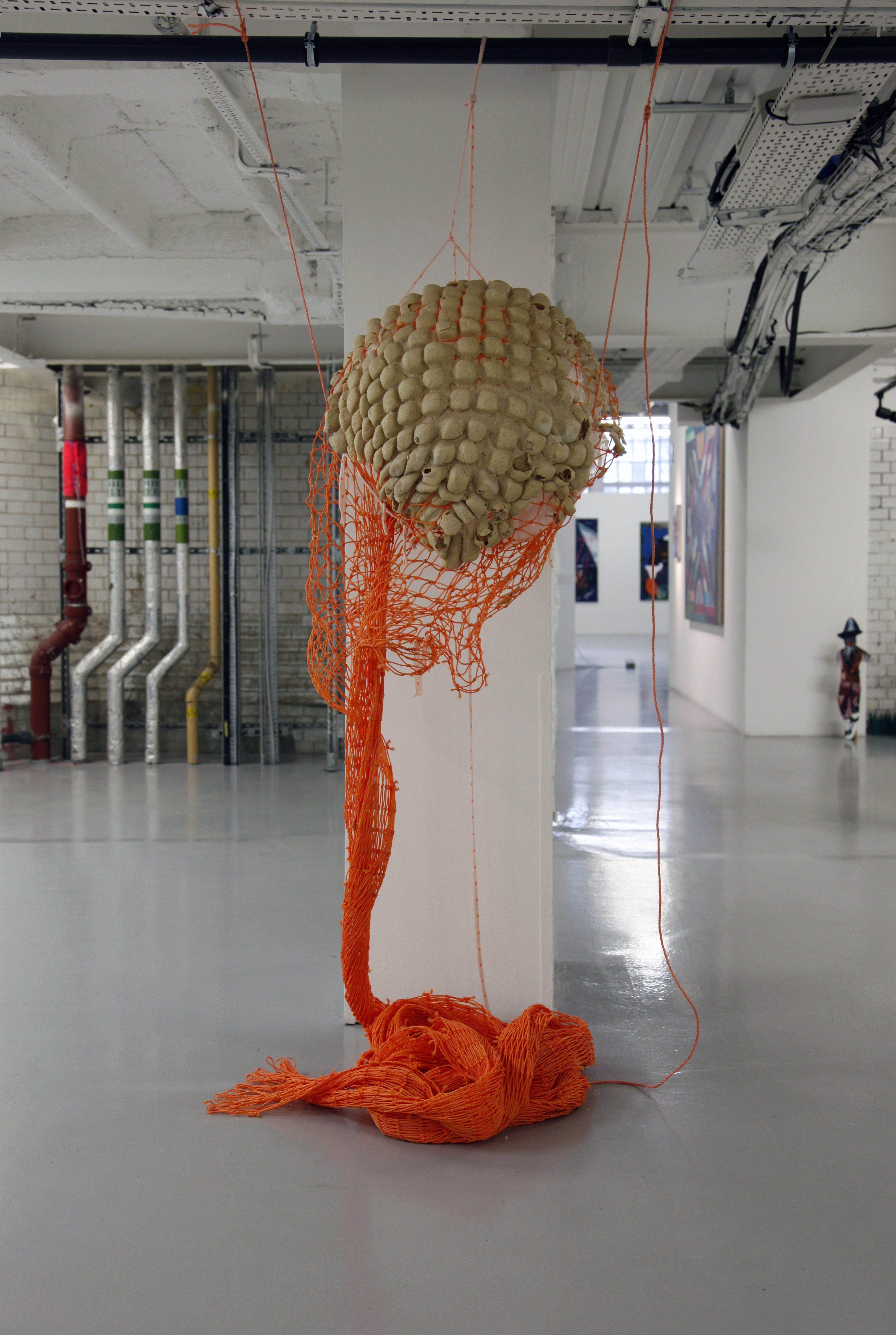Emily Motto
Interview by David McLeavy
Published February 2015
-
Emily Motto uses photographic material along with more malleable substances such as bread and playdough to create high impact and colourful sculpture. By leaving various elements up to chance, Motto's work continues to change throughout it's lifespan.
-
You use a very varied array of materials within your work and I would like you to talk a little more about these objects in regards to how you select them and why they are so important to your work.
I like to work with materials that have a sense of independence in terms of their properties, and that often have a transience or instability in terms of their physicality.
In making my sculptures I have been playing with materials such as playdough that changes in response to surrounding environments – as in a bodily capacity (which is currently crystallizing at the ICA in the New Contemporaries show); collaborating with yeast reactions to expand bread into new forms – as in airheads; and experimenting with weights of materials to distort underlying structures and transform/support forms – such as my net and playdough parasites.
I am really excited by how my sculptures perform and evolve throughout, and beyond, my creation of them – especially in terms of their shape. I enjoy delegating certain elements of the making process to properties of the materials I make and choose – although there is still a control retained behind their processes.
I think the tactility of many of the materials I use is also a very important aspect. They provoke an instinctive curiosity from the viewer. I guess the forms are quite attention seeking! I’ve recently been using large paper photographs as material for my sculptures, which I find have a curious tactility too, in presenting something seemingly virtual, but in a physical tangible form.
The materials that I choose, make and employ really are crucial to my work. They allow the sculptures to behave like figures; sensual, tactile, fragile, unstable and transient.

Two empty postures (the miserable comforters), wire mesh, homemade playdough, coloured thread, wool, spray paint, talcum powder, 2014
You mentioned that you have started to use digital imagery within your sculptural arrangements. Could you talk a little more about the selection of the imagery and how it feeds into your visual language and fits with the more transformative materials such as bread?
The imagery I have been using has been taken from photographs of figures I’ve found posted online. I was excited to enlarge them to expose the construction of their depictions – printing the pixels experienced when viewed online as 1-inch squares – the same size as the mesh frames used for playdough extrusions in the arrangements.
So many of our relationships between different bodies and figures are now mediated by the internet, and represented by single-faceted images rather than physical people. These pixelated structures seem to form the basis of so many of our ‘human’ interactions with each other at the moment, and I wanted to use my arrangements with them as opportunities to experience these versions in a more tangible and physical environment. In association with my other sculptures, they also communicate as figures, but through a very separate language.
Recently I have been using these images as a kind of fabric, and stitching them into tall hollow forms. From afar, areas of images can be distinguished from the sculptures’ surfaces, but separately from their fragile, handmade materiality – and I’ve been excited to use the tactility of these soft forms, and the presence they hold in the space, to play with this contradiction in the viewers’ senses.
I am also fascinated by how these structures appear when documented in photographs themselves – using combinations of sharp pixels and blurred areas occurring from processes of enlarging to create new planes in the visual field. I love how they trick the eye, suggesting the forms feature something virtual, or that the documentation has been edited.
In terms of how they fit with more transformative materials, in Moira’s Lounge I played with juxtaposing these regular photographic pixels with the organic ‘pixels’ of the extruded bread through squared mesh and net structures. As the images were enlarged, the regular pixelated construction became more apparent; whereas when I tried to extrude bigger versions of my smaller bread experiments, the forms became less defined. Using a larger volume of bread meant that the forms grew in a way that was much more difficult to control. They’re much more messy. Naturally, I suppose.

Teethy Tower, extruded bread form, photograph, wool, 2014
What do you think is the role of the artist?
I think there can be many. Something I find significant at the moment is how an artist is able to reveal something intrinsic through making things in a material-lead way. I think by constantly making, artists can expose an innate curiosity of things around them – of textures, shapes, surfaces, perspectives, processes etc…. – which can resonate with other people who experience their work.

Moira's Lounge, structures involving rising bread, play dough and facebook images, 2014
Do you often think about the way a viewer may encounter your work and if so does that influence the formulation of the art work in any way?
Yes definitely. When making the Empty Postures I was really excited by how they held and contained the space, and seemed to embody the presence of an extra person in the room through their scale and poise – even in their transparent and roughly crumpled forms. And this needed a viewer to feel.
Actually, dogs have had fascinating responses to my work in the past! One looked as if it was heading to eat the fluorescent playdough extruding from the bottom of Parasite at the opening of one show, but then flinched and ran away from the piece when it got too close. That was very exciting.
I think by physically moving between them, and sharing their space with these forms, viewers instantly add to the work – their experiences and familiarities – of surfaces, of balance, of fragility, of precariousness etc. – and an awareness of being a viewer, which bring all these relationships with the forms I make. I’m fascinated by these.
So yes, anticipated encounters definitely influence how I make my sculptures – for example when considering their scale, how they are installed, and the materials I use – their tactility and unsteadiness, for instance, that I find when experimenting in the studio.

Fig. 3, 5mm film (photograph featuring a form made from a large format print on mulberry paper, stitched with wool), 2014
You had been selected for Bloomberg New Contemporaries in 2014 and I wanted to hear your thoughts on the exhibition and the experience of being part of it. Has it changed your work in any way or has it aided your development as a young artist?
It’s been so exciting being a part of the New Contemporaries and having the opportunity to show my work to so many people.
One of the best parts was meeting lots of the other artists who were selected – we’re all in similar positions in either our first or second year out of art school, so it’s been really inspiring to have that community and see how everyone’s managing with everything after graduating.
The mentoring by Artquest was also really helpful, especially for me this year in helping structure my practice and giving practical advice on being a self-employed artist.
And in terms of changing my work, I found it a really valuable experience to revisit the pieces that were selected for the show, which actually were originally made nearer the beginning of my degree, and having the opportunity to remake them in this new context.

Extruded form with heavy head, bread, net, exercise ball, 2014
How do you find the work/art work balance and do you feel there are enough opportunities available for young artists like yourself to take advantage of?
There seem to be a lot of opportunities for recent graduates and emerging artists, which is really great, but then again there are a lot of recent graduates and emerging artists… At the moment I feel really fortunate that the opportunities that have come my way since graduating have allowed me to put all my energy into making my work.
Then again, opportunities don’t always mean funding, which has been quite challenging at times - especially as my work is often quite transient and site specific, and often needs to be remade. It’s difficult. It can be such a cost to actually take up exciting opportunities, but in such a saturated and competitive environment they often seem completely necessary - especially for young artists.

A Bodily Capacity, homemade playdough, steel mesh, copper, foam floats, yarn, rope and wool, three hours, one person, 2014
-
Emily Motto lives and works in London. Recent exhibitions include Bloomberg New Contemporaries, ICA, London, Saatchi New Sensations 2014, Victoria House, London and The Gallery North Woon Exhibition 2014, Newcastle
-
If you like this why not read our interview with Sam Lyon
-
© 2013 - 2018 YAC | Young Artists in Conversation ALL RIGHTS RESERVED
